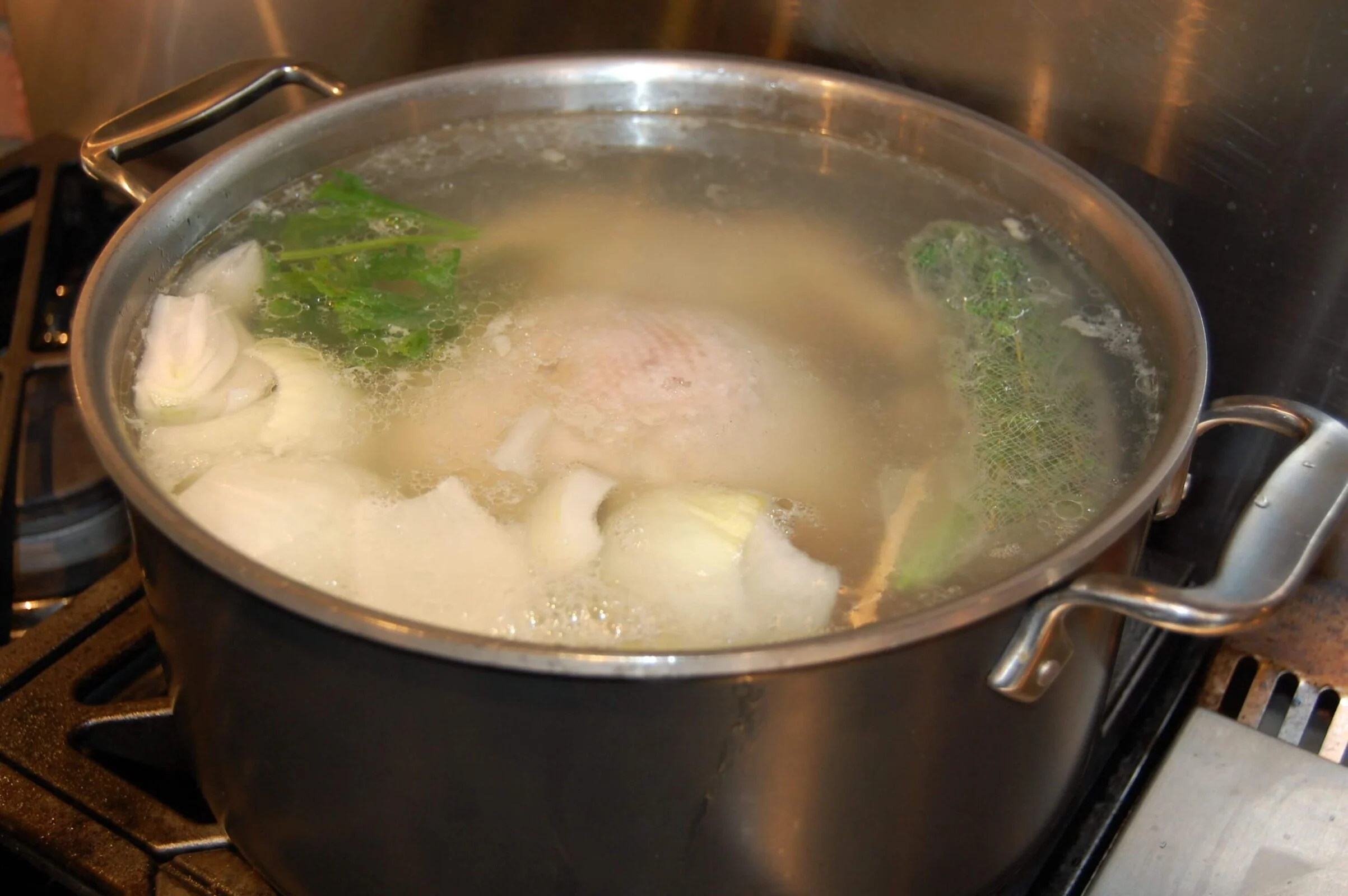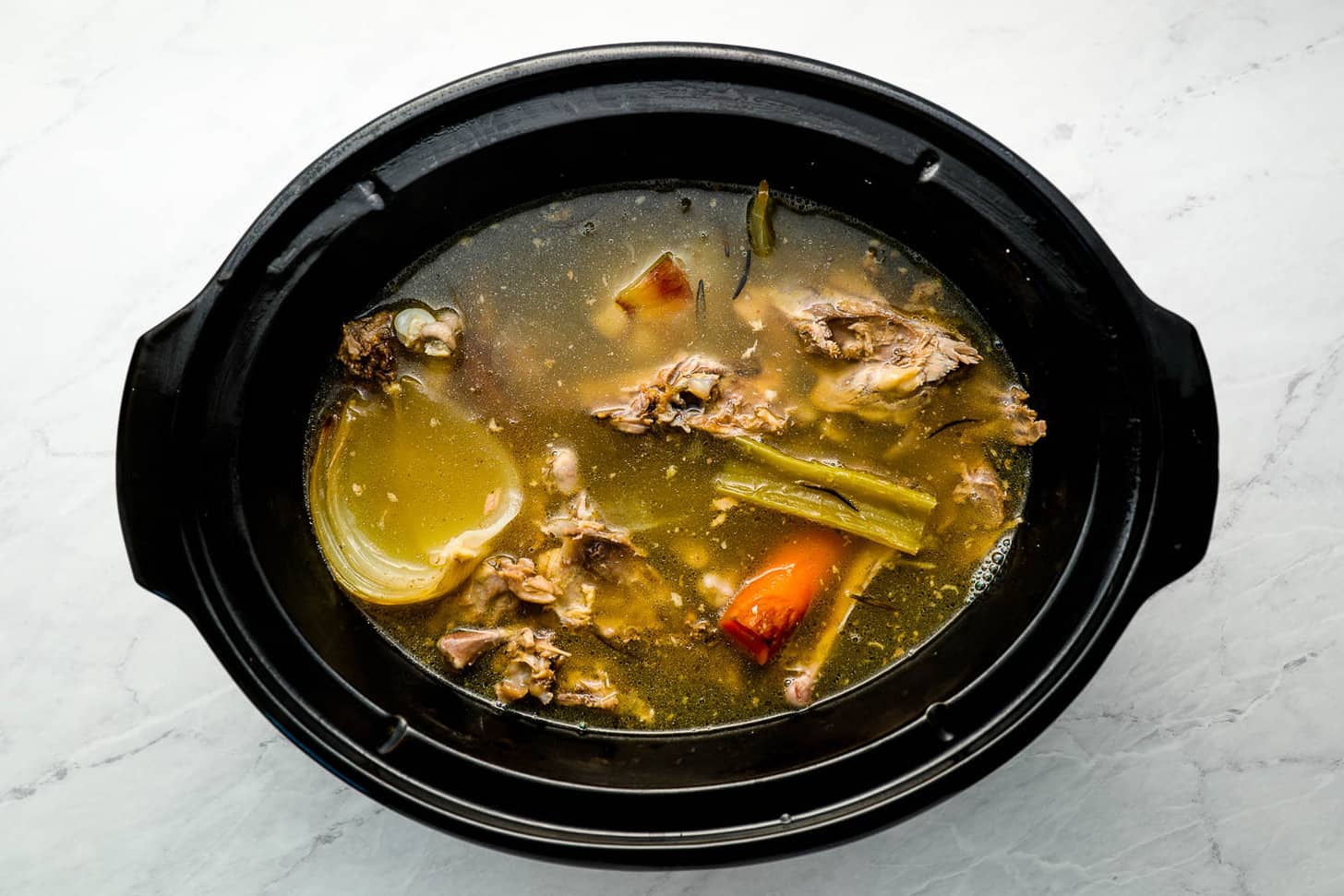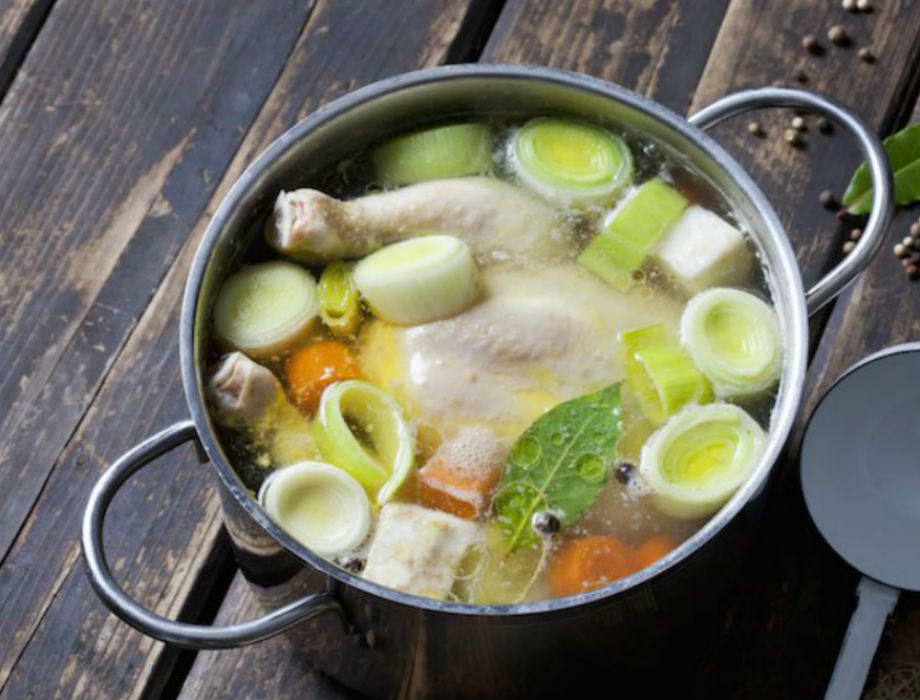
Are you ready to elevate your culinary prowess and add a delicious, nutritious twist to your homemade dishes? Look no further! Our comprehensive guide is here to unlock the secrets of How To Make And Store Homemade Chicken Stock Or Bone Broth? Whether you're a seasoned chef or a kitchen novice, we've got you covered with step-by-step instructions, insider tips, and a mouthwatering recipe that will leave your taste buds dancing with joy.
Your kitchen adventures just got a whole lot more exciting! Making and storing homemade chicken stock or bone broth has never been easier, and we've got the keyword to success: 'simplicity.' This guide is tailored to match your intent, whether it's wholesome family dinners, quick weeknight soups, or gourmet creations.
Homemade Chicken Stock
In the realm of culinary artistry, chicken stock stands as a cornerstone, a foundation upon which countless dishes are built. Its rich, savory essence adds depth and complexity to soups, sauces, stews, and gravies, transforming ordinary meals into symphony of flavors. While store-bought options provide convenience, embarking on a homemade chicken stock adventure unveils a world of culinary satisfaction and unparalleled flavor.
Gathering Ingredients
The journey begins with assembling the essential ingredients that will orchestrate a symphony of flavors. At the heart lies the star of the show – chicken bones, preferably a combination of roasted and unroasted to impart a balance of depth and richness.
Next, a medley of aromatic vegetables joins the ensemble, each lending its unique character: onions, carrots, celery, and leeks, their sweet and earthy notes harmonizing beautifully. A bouquet garni, a bundle of fresh herbs such as parsley, thyme, and bay leaves, adds a touch of complexity and depth.
Roasting The Bones
Before embarking on the simmering journey, a crucial step awaits – roasting the chicken bones. This process unlocks hidden depths of flavor, transforming bland bones into flavor powerhouses. Scatter the bones on a baking sheet and roast them in a preheated oven, allowing their edges to caramelize and release a wealth of savory compounds.
Simmering To Perfection
With the roasted bones as the foundation, the next stage involves a slow dance of flavor extraction. Transfer the roasted bones, along with the unroasted ones, to a large stockpot. Add the aromatic vegetables, bouquet garni, and enough water to cover the ingredients by at least two inches. Bring the mixture to a boil, then reduce the heat to a gentle simmer.
Over the next few hours, the magic unfolds as the simmering process coaxes out the essence of the ingredients, transforming them into a flavorful broth. The chicken bones release their savory goodness, the vegetables impart their sweetness and earthiness, and the herbs infuse their subtle aromas.
Straining And Clarifying
After hours of simmering, the broth has reached its peak of flavor. Now comes the time to separate the solids from the liquid, leaving behind a clear, velvety broth. Carefully pass the simmered mixture through a fine-mesh strainer or cheesecloth, ensuring that no solids escape.
For an extra touch of finesse, consider clarifying the broth. This process involves gently whisking egg whites into the strained broth, then bringing it to a simmer. The egg whites attract impurities, rising to the surface as white foam. Skim off the foam, and the result is a crystal-clear broth.
Tips And Variations - Enhancing Your Broth
As you embark on your homemade chicken stockjourney, consider these tips and variations to enhance your experience:
- Experiment with different types of chicken bones – chicken backs, necks, and wings can add unique flavors.
- Add a splash of apple cider vinegar or lemon juice to brighten the broth's flavor.
- Roast vegetables for a deeper, more intense flavor.
- Incorporate additional herbs and spices, such as peppercorns, star anise, or ginger, for a personalized touch.
- Experiment with different simmering times – longer simmering produces a richer, more concentrated broth.
Storing And Preserving
Proper storage and preservation are essential for maintaining the quality and flavor of your homemade chicken stock. Here's a comprehensive guide to ensuring your culinary masterpiece remains fresh and delectable:
Refrigeration
- Cooling -Allow the cooked chicken stock to cool completely to room temperature before storing it. This prevents condensation and the growth of bacteria.
- Choosing Airtight Containers - Transfer the cooled stock to airtight containers, such as glass jars with tight-fitting lids or BPA-free plastic containers specifically designed for food storage.
- Labeling and Dating -Label the containers with the contents ("Homemade Chicken Stock") and the date it was cooked. This helps you keep track of its freshness.
- Refrigerator Storage -Store the chicken stock in the refrigerator for up to 5 days.
Freezing
- Freezing in Portions -Consider freezing the stock in various increments, such as ice cube trays or muffin tins, to easily thaw and use smaller amounts as needed.
- Leaving Headspace - When freezing the stock in containers, leave some headspace to allow for expansion as the liquid freezes.
- Labeling and Dating -Label the frozen containers with the contents ("Frozen Chicken Stock") and the date it was frozen.
- Freezer Storage -Store the frozen chicken stock in the freezer for up to 3 months.
Additional Tips
- Skimming Off Fat -If you prefer a low-fat stock, you can skim off the fat that rises to the surface after the stock has cooled.
- Slow Thawing -When thawing frozen stock, thaw it slowly in the refrigerator or microwave to ensure even defrosting and prevent the loss of flavor.
- Reusing for Future Batches -Use leftover stock to add flavor and depth to new batches of chicken stock.
Flavorful Variations And Recipes
Homemade chicken stock is a culinary foundation that can be infused with a variety of flavors and spices to create unique and delectable variations. Here are some flavorful variations and recipes to explore:
1. Asian-Inspired Chicken Stock - Infuse your chicken stock with an Asian twist by adding ginger, garlic, and a touch of soy sauce for a savory, umami-rich broth. This variation pairs perfectly with stir-fries, noodle soups, and Asian-inspired dishes.
2. Mediterranean Chicken Stock - Embrace the flavors of the Mediterranean with sun-dried tomatoes, oregano, and a hint of lemon zest for a bright and flavorful broth. This variation is ideal for soups, stews, and grain dishes.
3. Herb-Infused Chicken Stock - Enhance the aroma and complexity of your chicken stock with a generous bouquet of fresh herbs. Parsley, thyme, bay leaves, and a touch of rosemary will add depth and dimension to your broth.
4. Spicy Southwestern Chicken Stock - Add a kick of heat to your chicken stock with roasted poblano peppers, a touch of chili powder, and a pinch of cumin for a warm and flavorful variation. This broth is perfect for simmering enchiladas, chili beans, and southwestern-inspired dishes.
5. Lemon-Herb Chicken Stock - Brighten your chicken stock with a zesty infusion of lemon juice, zest, and fresh herbs like parsley and dill. This variation is ideal for poaching fish, vegetables, and delicate dishes.
Recipes
1. Creamy Chicken and Vegetable Soup - Transform your homemade chicken stock into a comforting and creamy soup. Sauté onions, carrots, and celery, add shredded chicken, and simmer in your flavorful chicken stock. Stir in cream, milk, and a touch of nutmeg for a velvety and satisfying soup.
2. Chicken and Dumplings - Embrace the classic comfort food of chicken and dumplings. Simmer your homemade chicken stock with vegetables and cooked chicken. Prepare fluffy dumpling dough and drop it into the simmering broth for a hearty and satisfying meal.
3. Chicken and Rice Pilaf - Infuse your rice pilaf with the rich flavors of your homemade chicken stock. Sauté onions and garlic, add rice, and toast it briefly. Pour in your chicken stock, bring it to a simmer, and cover the pot for a flavorful and aromatic rice pilaf.
4. Chicken and Noodles - Create a simple yet satisfying dish with chicken and noodles. Simmer your homemade chicken stock with vegetables and cooked chicken. Add your favorite noodles, such as egg noodles or rice noodles, and cook until tender for a comforting and satisfying meal.
5. Chicken and Vegetable Stir-Fry - Elevate your stir-fry with the depth of flavor from your homemade chicken stock. Sauté vegetables and cooked chicken, then add a splash of your chicken stock and stir in a cornstarch slurry for a flavorful and satisfying stir-fry.
Culinary Delights
Here are some culinary delights that can be made using chicken stock:
Soups
- Chicken Noodle Soup - A classic comfort food, this soup is made with chicken, noodles, vegetables, and chicken stock.
- Chicken and Dumplings - This hearty soup is made with chicken, dumplings, vegetables, and chicken stock.
- Chicken and Corn Soup -This light and flavorful soup is made with chicken, corn, vegetables, and chicken stock.
- Chicken and Potato Soup -This creamy and satisfying soup is made with chicken, potatoes, vegetables, and chicken stock.
- Chicken and Lentil Soup -This hearty and healthy soup is made with chicken, lentils, vegetables, and chicken stock.
Sauces
- Pan Sauce -This versatile sauce is made with chicken stock, butter, flour, and seasonings. It can be used to deglaze a pan and create a flavorful sauce for meats, vegetables, or pasta.
- Gravy - This rich and savory sauce is made with chicken stock, flour, butter, and seasonings. It is a classic accompaniment to roasted meats and poultry.
- Tomato Sauce -This flavorful sauce is made with tomatoes, chicken stock, onions, garlic, and seasonings. It can be used as a base for pasta sauces, stews, and soups.
- Cream Sauce - This rich and creamy sauce is made with chicken stock, cream, butter, flour, and seasonings. It can be used to top pasta, vegetables, or meat.
- Wine Sauce -This elegant sauce is made with chicken stock, wine, butter, flour, and seasonings. It is a classic accompaniment to grilled meats and poultry.
Stews
- Chicken Stew -This hearty and flavorful stew is made with chicken, vegetables, and chicken stock.
- Beef Stew -This classic stew is made with beef, vegetables, and chicken stock.
- Lamb Stew -This rich and savory stew is made with lamb, vegetables, and chicken stock.
- Vegetable Stew -This healthy and flavorful stew is made with vegetables, chicken stock, and herbs.
- Irish Stew - This hearty and traditional stew is made with lamb, potatoes, vegetables, and chicken stock.
Other Culinary Delights
- Risotto -This creamy and flavorful rice dish is made with rice, chicken stock, cheese, and butter.
- Polenta - This creamy and satisfying cornmeal dish is made with cornmeal, chicken stock, and butter.
- Quinoa -This healthy and versatile grain can be cooked in chicken stock for added flavor and nutrition.
- Pasta -Pasta can be cooked in chicken stock for added flavor and richness.
- Vegetables -Vegetables can be steamed or simmered in chicken stock for added flavor and moisture.
These are just a few of the many culinary delights that can be made using chicken stock. With its rich flavor and versatility, chicken stock is an essential ingredient in any kitchen.
Health Benefits
Chicken stock is a nutritious and versatile ingredient that offers a variety of potential health benefits. Here's a summary of some of the key benefits:
1. Hydration and Nutrient Replenishment - Chicken stock is a good source of fluids and electrolytes, which can help replenish lost fluids and minerals, especially during or after exercise or illness.
2. Digestive Support -The amino acids and gelatin found in chicken stock can promote gut health and aid in digestion.
3. Immune System Support -The minerals and vitamins in chicken stock, such as zinc and vitamin B6, can contribute to a healthy immune system.
4. Joint Health Enhancement -The collagen and gelatin in chicken stock may help support joint health and reduce arthritis-related pain.
5. Skin Health Improvement -Collagen, a protein found in chicken stock, may help improve skin elasticity and reduce the appearance of wrinkles.
6. Anti-inflammatory Properties - Certain components of chicken stock, such as glycine and proline, may have anti-inflammatory effects.
7. Appetite Stimulation -The savory aroma and flavor of chicken stock can stimulate appetite and encourage food intake, especially for those with reduced appetite.
FAQ's About How To Make And Store Homemade Chicken Stock Or Bone Broth?
How Long Does Homemade Chicken Bone Broth Last?
3-4 daysChicken broth can be refrigerated for 3-4 days and frozen (for best quality) for 2-3 months.
What's The Difference Between Broth And Stock?
Stock is generally made from bones, and broth is generally made from flesh. In both cases, they are often supported with aromatic vegetables, but in the case of stock, left unseasoned for maximum flexibility in recipes, whereas broth will usually contain at least salt and pepper.
Which Is Richer Broth Or Stock?
As a result, stock is usually a healthier product, delivering a richer mouth feel and deeper flavor than broth. Stock is a versatile culinary tool that can deliver taste to any number of dishes. Darker in color and more concentrated in flavor than broth, it's ideal for use in soups, rice, sauces and more.
Conclusion
In conclusion, homemade chicken stock and bone broth are more than just ingredients in your kitchen, they're the keys to unlocking a world of flavor, nutrition, and culinary creativity. With the knowledge and skills you've gained from our guide, you're now equipped to whip up these liquid gold elixirs with confidence.
As you embark on your journey of crafting and storing homemade chicken stock or bone broth, remember that the possibilities are endless. Experiment with different ingredients, herbs, and spices to create your signature flavor profile. Share your culinary delights with friends and family, and watch their faces light up in delight.



